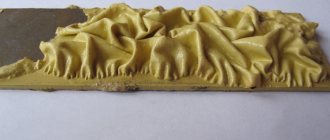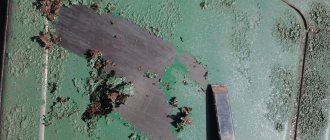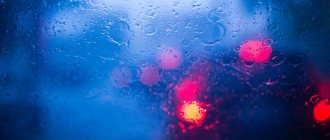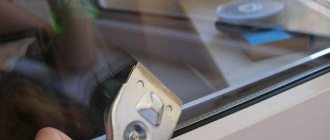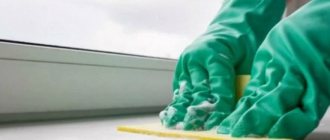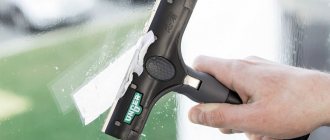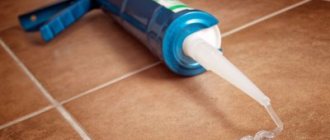27.09.2019
| (Votes: 4, Rating: 4.5) |
Issues discussed in the material:
- How to wash car windows so that there are no streaks left
- How to remove paint from car glass
- How to clean car windows after tinting
- How to clean car windows from plaque inside the cabin
Washing car windows (especially the windshield) is a fairly important task that affects safety while driving. This job requires a lot of patience. Plain water will not always be able to completely clean the glazing, but using a soap solution will lead to streaks. Then how to wash car windows both outside and inside? There are suitable options. Let's talk about them.
Modern methods of damage removal
Along with folk methods, there is a whole class of professional car care products that can be easily purchased in specialized stores.
How to remove silicone sealant from plastic windows? Some of them are useful to adopt now. 1. A fairly common remedy is scratch remover paste. However, few people know that it is effective not only in combating mechanical damage, but also can erase traces of paint. Apply the product to a dry cloth and wipe the areas stained with paint until the stains disappear completely.
It would be optimal to purchase a special microporous sponge along with the paste.
3. Automotive experts say that a brake pad cleaner spray can also cope with dirt. You need to apply the product to a rag, treat the stain with small fragments and wipe with a dry cloth.
This product is well suited for the type of stain where the paint mark is easily pressed through with a fingernail.
How to remove fresh stains
If the paint coat is recently applied, there is no need to use chemicals. Simply moisten the sponge in warm water and rinse the surface. To clean your brushes after use, leave them in water for 15 minutes and then hold them under pressure. When the contamination is fresh, but has landed on a surface that is quickly eaten into, additional products will need to be applied.
Sunflower oil and laundry soap
It is very difficult to remove even fresh paint stains from clothes, and the result directly depends on the type of fabric. Immediately after the substance gets on clothing, it is necessary to treat the area with sunflower oil and soak for 15 minutes in hot water, after rubbing with laundry soap. After soaking, you should wash the clothes in a washing machine or by hand.
White Spirit
Paint stains can be removed from most fabric surfaces using white spirit. To wipe off paint with a solvent, you need to apply a small amount to a rag or sponge and gently rub it over the dirt.
Isopropyl alcohol
Isopropyl alcohol is an organic solvent. To remove dirt from the surface, you need to apply alcohol and wash it off after a few minutes. If the paint begins to eat in, you should use a hard sponge.
Nail polish remover
You can remove acrylic paint from clothing or fabric surfaces using nail polish remover that does not contain acetone.
This is important to preserve the structure and color of the material. Nail polish remover effectively removes only fresh stains
Ammonia and vinegar
In cases where it is not possible to remove the paint using other methods, you can use vinegar and ammonia. It is enough to soak a cotton pad or soft cloth in the solutions, and then treat the stain until it completely disappears.
Hair fixation spray
Applying hairspray to fresh acrylic paint affects its texture and makes it easy to wash off. The composition peels off from exposure to the varnish, and it is enough to treat the surface with a rag or sponge.
Removing pollen with an auto scrub
Auto scrub is an alternative to cleaning clay and is produced in different versions - a circle (for working with a polishing machine, as well as manually when using a special holder), a mitten, a towel, a sponge (for working manually). It can have different gradations (aggressiveness of impact). When using an autoscrub for machine processing (Autoscrub Foam Pad), it is recommended to use a dual-action (eccentric) polishing machine, since a rotary machine will be too aggressive on the paintwork.
Auto scrub is used with a lubricant or soap solution.
The close-up photo shows pollination along with traces of water droplets. This contamination occurred when the car was parked close to workers who were painting something. The most damaged part was the trunk lid. The surface was very rough, and the contamination was not washed off.
For cleaning, a medium grade Nanoskin Autoscrub wheel was used on an orbital polisher with a large amount of lubricant (diluted Nanoskin Glide). This is a foam circle combined with a very soft rubber surface. After removing dirt and wiping with microfiber, the surface was polished.
Choosing a remedy
You can clean acrylic paint from walls and floors after renovation using both professional household chemicals and proven home methods. Let's take a closer look at each group.
Purchased
Undoubtedly, the most effective way to wash acrylic paint is with special wash-off compounds that can be purchased at a hardware or hardware store. We list the highest quality products:
- Chief technologist. The universal remover has a gel consistency. Suitable for cleaning acrylic paint, including façade paint, of any color from wood, concrete, and metal. At the same time, the cost of the product fluctuates around two hundred rubles.
- The paint remover will help to thoroughly clean metal and wooden surfaces. The exposure time is ten to fifteen minutes. The price is about four hundred rubles.
- Prestige. The product will allow you to quickly wash acrylic paint both indoors, for example, from a laminate floor or ceiling, and outside. Suitable for removing other paints and varnishes. Prestige costs about two hundred and fifty rubles.
Expert opinion Natalya Osadchaya
It is worth considering that the listed household chemicals are quite toxic, so before using them you must carefully read the safety precautions on the packaging.
Folk
Minor fresh stains can easily be washed off with proven folk remedies. Let's list a few of the most effective:
- Warm water. Ideal for removing fresh acrylic paint stains from canvas or wallpaper. You just need to lightly rub the stains with a damp cotton pad. In this case, you need to make sure that the walls do not get wet, otherwise the blot will increase in size. You can also clean the roller in a bucket of clean water.
- Nine percent table vinegar. Suitable for cleaning linoleum or laminate flooring. The method of application is similar. After cleansing, you will need to rinse off the acetic acid with water.
- Nail polish remover. Allows you to clean plastic and varnished surfaces from fresh blots.
Contrary to the popular belief of most housewives, cleaning acrylic paint at home is not so difficult. The main thing is to arm yourself with the tips listed in this article. Then the cleaning will be a plus.
Mechanical impact
An old, good, proven method that our parents and grandparents used. To begin with, the area stained with paint should be thoroughly treated with any degreaser, for example, alcohol or a special glass cleaner based on it. Now you should apply a soft (preferably lint-free) rag soaked in hot water, or even boiling water, to this area. Secure it so that it does not slide off the contaminated area. This can be done with regular tape. In this position, the hot cloth should act on the surface for about ten to fifteen minutes. You can add hot water a little on top to better affect the paint. After this, you can proceed to active actions: carefully scrape off the paint with a sharply sharpened stationery knife. If you don’t have one, an ordinary blade (the same one that was previously used in old men’s razors) will do just fine.
Washing a dirty car
Paint that gets on the car body causes serious concern and inconvenience to car owners. After all, it is very difficult to remove paint from a car, even small traces of it, without damaging the paintwork of the body.
But if you wish, you can try to get rid of unnecessary “artwork” on your car, acting thoughtfully and carefully. First of all, in this case, success depends on the speed of reaction to the problem
It is easier to wipe off fresh paint without further damage to the coating. Old traces are almost impossible.
Gentle solvents such as gasoline and white spirit are suitable for removing paint. Some car owners recommend non-standard solutions - treatment with brake fluid or alkaline compounds (sodium hydroxide)
When using them, it is important to be extremely careful - treat the stain directly without touching clean areas of the surface, do not leave solvents on the stains for a long time and clean off the paint with smooth cross-shaped movements, without excessive zeal. If there is a subtle change in the color or gloss of the surface, treatment should be stopped immediately and the solvent wiped dry.
Clay for car cleaning (“Willson”, “SONAX”, “ZM”, “Detailing clay”) is a new product on the market of cleaning products for cars. Designed to remove bitumen stains, but also successfully copes with minor paint stains. Purchased from auto stores and used according to instructions.
Cleaning any surface from paint stains is a labor-intensive and complex task that requires a competent approach. Only by studying and choosing the right methods for removing contaminants can you achieve success and return any things to their former appearance - from your own skin to clothes and cars.
How to choose what is best to clean a window?
The choice of method is determined by:
- the extent of the affected surface;
- how old the blots and drips are.
For fresh stains, simply using a damp cloth will solve the problem. And you will have to tinker with old traces of staining using the above methods.
For small stains, a mechanical method is suitable to remove splashes from the surface . In case of significant staining of glass with paint, chemical and thermal methods are suitable. High temperature treatment can also be used for old multi-layer stains.
When exposed to chemical reagents, it is necessary to strictly follow safety precautions and prevent solvents from getting on the frame and window sill. When working with windows, the use of solvents in a spray is undesirable, since it is difficult to control the coverage area.
Very often it is necessary to use several methods , combining them to obtain the best result.
Liquid chemicals used to remove paint are toxic.
Features of the composition
Acrylic paint is applied to various surfaces, including:
- tree;
- fabrics;
- plastic;
- concrete;
- brick;
- glass.
During construction and renovation, multifunctional coating is used for both external and internal work. The choice of paint color is practically unlimited. In addition, it does not flow down on vertical planes, fits well, and does not form any streaks or unevenness.
The paint is safe for people, it can even be used in children's rooms. An undoubted advantage is the ability of the coating to allow air to pass through and resist moisture. On surfaces treated with acrylic paints, mold does not appear and fungus does not grow.
Unlike oil paint, acrylic paint is odorless, dries quickly and does not crack. It is not surprising that it is preferred in most cases when renovating residential, industrial and office premises. The excellent characteristics of paints are due to their composition. The composition may differ slightly from one manufacturer to another. However, for all paints belonging to this category, the following ingredients are required:
- binder base;
- acrylic fillers;
- pigments;
- additional additives.
The binding base plays the main role: it unites all the substances included in a single composition. The base is a water-soluble polymer material. To produce the main component, acrylic resin is required. The base provides the paint with color fastness.
Acrylic fillers are needed for:
- improving the protective properties of dyes;
- uniform color distribution within the composition;
- increasing the adhesion of the applied material to the surface being treated.
The color or shade of paint depends on the pigments. Essentially, pigments are powders made up of tiny particles. Once in the composition, the particles do not dissolve, but are evenly distributed throughout the entire volume of the liquid. Pigments, depending on their origin, are divided into:
- organic;
- inorganic;
- natural;
- piece.
Additional additives are needed to obtain certain characteristics. For example, they increase moisture resistance. The presence of some additives allows you to obtain a matte surface, while others - a glossy one.
Removing paint from glass
A razor blade can be used as a mechanical tool
Cleaning methods depend on how long it has been since the drops hit the glass. For complex stains, you usually have to combine them.
Physical impact
The simplest method that requires some effort and attention. Small stains and drips are removed with mechanical tools. The easiest way is to wipe the paint off the window glass before it has time to dry. In this case, it is enough to clean it with a rag or paper towel. To remove old stains you will need:
- knife,
- razor blade,
- metal scraper.
The main condition is that the tool used must be sharp. A dull blade will not remove hard stains, and excessive force can damage the glass itself.
Chemical exposure
Industrial liquids and solvents help remove paint from glass:
- acetone,
- White Spirit,
- turpentine,
- petrol,
- kerosene.
To wash off acrylic paints, you can use industrial alcohol.
Paint manufacturers produce a variety of removers, under the influence of which they must be cleaned. But in fact, these liquids can easily remove only fresh paint from glass.
Dried layers and stains have to be removed in two stages. First, you need to soak them in a solvent and scrub off what gives in with a little pressure. The remaining solid paint is once again watered with technical liquid, after which it will be easier to remove it with mechanical tools.
Another method of softening a dried layer is based on the use of liquid oil. It takes a lot of time and works best on horizontal glass. The stains are poured with oil, a rag is moistened in it and the glass is covered at the place of contamination. Everything should remain in this form for 2 - 3 hours. After this, the softened layer should be easier to wipe off with a scraper or razor.
Temperature treatment
A hair dryer will help soften the paint
You can soften old paint by heating. This method requires the use of devices that, if handled improperly, can damage the glass or window frame. However, it is effective in the following cases:
- paint stains are very old and dried;
- pollution covers a large area;
- glass is covered with a thick layer;
- other methods are not able to cope with contamination.
You can heat the paint with a hairdryer. It is better to use not a household device, but a construction device that can heat the air to high temperatures. But there is a danger of overheating with it. If you don’t have a hairdryer, you can use an iron; to do this, cover the areas to be cleaned with metal foil.
Sequencing:
- wash the glass from dust and ordinary dirt;
- wipe dry;
- cover contaminated areas with foil, securing it with tape;
- heat the paint through the foil with a hairdryer or iron it;
- scrape off the softened layer with a knife.
This treatment can remove even the oldest paint.
What to do if paint gets on the windshield and interferes with your view
There are two ways to remove paint from a windshield:
- If the paint has dried, it can be removed with a plastic spatula, just like when painting a home window. The easiest way to remove residues is with a cloth soaked in solvent.
- If you cannot remove the paint with a plastic spatula, try cleaning the surface with a metal or razor blade, but very carefully, making movements parallel to the glass, otherwise you may scratch it.
At service stations, paint is removed from glass in the same way, and from painted surfaces - by abrasive polishing.
Reliable stain remover
Paint stores sell paint remover. This is a specially formulated chemical. There is both a universal product and one made only for acrylic. It has a strong unpleasant odor.
Removing stains with this preparation must be done with the window open. Hands, respiratory organs and eyes must be protected with special means - gloves, a respirator and goggles.
To remove stains you need:
- moisten the fabric in the product;
- wipe the surface to be treated;
- wait 10 minutes and wipe off any drops or streaks with a clean rag;
- After completing the procedure, the treated surface must be washed with warm water and soap.
This universal substance helps remove drops and streaks from any surface. For it, there is no concept of timing for the appearance of stains, since it removes traces of acrylic after a long time. However, due to the aggressive composition of the drug, it should be used as a last resort when other means have not helped.
It is commonly believed that waterborne paints are highly flammable, and this is true. They are especially dangerous in the first minutes after application. However, sometimes serious complications can arise, since each paint has certain additives that give it certain qualities. Acrylic paints are actively used in everyday life, and there are often times when it needs to be washed or removed from some surface.
Acrylic paints contain water, a pigment that gives color, acrylic acid, a film-forming substance, due to which the layer hardens in just an hour. For this reason, the sooner the process of removing paint from surfaces begins, the easier it can be done. Today we will learn how to quickly and easily remove acrylic paint from various surfaces.
Acrylic can be removed from the surface in several ways. In this case, you will need to use certain substances and tools.
How to remove glue from car windows
Today, many well-known manufacturers of automotive gadgets for attaching to glass abandon glue in favor of suction cups that securely fix the device and do not leave marks. If the product is adhesive-based, then after removing it there will be a mark on the glass.
It can be washed using special products that are sold in automotive stores. Today, both imported and domestic products are offered. To remove traces of glue, you need to apply the composition, wait 3-5 minutes and then wipe the treated area dry with a rag.
Let us separately note three such means:
- LAUREL Antitopol . A good domestic composition intended for cleaning a car windshield from tree resins, traces of poplar buds, etc. It is also suitable for removing glue residues.
- Prosept Duty Scotch . A specialized solvent-based composition designed to remove traces of tape and glue. Avoid contact of the product with rubber or plastic products as it contains a solvent.
- LIQUI MOLY Aufkleberentferner . Another tool that allows you to quickly wash the glass surface of your car from glue and traces of stickers. It has the advantage of being absolutely non-aggressive to rubber and plastic. However, the cost of the composition is quite high.
Not all car owners have the opportunity to use the listed cleaning fluids. For such cases, there are other methods for removing the adhesive base.
For example, experienced car enthusiasts who attend various automotive forums are familiar with a product such as Dimexide. It perfectly removes glue residue from surfaces, so it can also be used to clean windshields. However, Dimexide has significant disadvantages. Firstly, the product has a rather unpleasant odor, which is difficult to get rid of. Therefore, it is extremely undesirable to use this composition for treatment inside the car interior. Secondly, it can corrode the paintwork, so you need to avoid getting the product on the painted surface. Otherwise, the use of Dimexide perfectly eliminates traces of glue on car glazing.
Alcohol will also effectively remove glue stains from any surface, including plastic and glass. Moreover, you can also use an alcohol-containing liquid (vodka, alcohol-based lotion, etc.). The main thing is that the alcohol is ethyl. Methanol and isopropanol are dangerous to use inside a car; their vapors can lead to poisoning. The smell of ethanol disappears very quickly, and the alcohol itself evaporates, leaving no traces.
We recommend
“Liquid glass for a car: effective protection and attractive appearance” More details
Another effective universal remedy is WD-40. It also helps remove the adhesive base from car glass and any other surface, and immediately after treatment it completely evaporates and leaves no odor.
Removing paint with a remover
Remover (solvent) for acrylic can be purchased at hardware or construction stores. This product is a clear liquid that is applied to the paint layer using a sponge or cloth. After this, you need to let the remover react with the paint (as a rule, the process lasts no more than 10 minutes), after which the acrylic along with the solvent is removed with a regular rag.
Today, acrylic paint remover can be called the most convenient and effective way to clean acrylic from a surface. It handles paint on both hard surfaces and fabrics. This product has its own specific properties, so consult the seller before purchasing and follow the instructions on the package.
Before you find out how to remove acrylic paint
, you need to figure out what it consists of and where it is used, otherwise maybe you are planning to wash off acrylic paint! Acrylic paint contains pigment and water with acrylic acid. It is used when carrying out interior finishing work on wooden surfaces. Acrylic paint contains a film former that hardens in about 30-60 minutes. The method used to remove acrylic paint from a surface is determined by the time that has passed since it was applied.
If you need to remove fresh acrylic paint that was applied an hour or two ago, you can easily do this with warm water. In order to clean acrylic paint from brushes, they need to be soaked in warm water for about twenty minutes, then washed under running water with soap or detergent.
If more hours have passed since the acrylic paint was applied, but no more than a day, you can use a brush, water or any product that is designed to degrease surfaces.
To remove acrylic paint that was applied a long time ago and whose film-forming layer has completely hardened, use gasoline, kerosene, white spirit, acetone or a special paint remover.
Take a sponge and moisten it with one of the presented products selected for cleaning the surface of acrylic paint, then leave it for half an hour to soften the hardened acrylic paint. After that, all you have to do is wipe the surface using a soft cloth soaked in any of the products presented.
In addition to the listed products, you can use a special product called “Paint Remover”. This product can be purchased at any hardware store. It can be special for removing acrylic or universal, suitable for any type of paint with any base
Before using the remover, take precautions. You need to open the windows and doors, put on gloves, goggles, a respirator, then apply the product to a rag, treat the surface, leave it for ten minutes, wipe the surface to be cleaned using a clean cloth
Be careful as the substance has a pungent odor and can corrode the skin of your hands.
Tips and tricks
There are several recommendations when carrying out cleaning work:
- Watch carefully to see if, in addition to unwanted coloring matter, paint from your car has appeared on the rag;
- If the glass gets dirty, you can use a blade;
- If the substance is in a thick layer on the body, first try removing the excess with a plastic scraper. Avoid contact of plastic with the body;
- if you doubt the effectiveness of the above products, try to find special products in stores for washing off substances from a spray can;
- If the above methods do not help, try using industrial alcohol or WD-40. Take precautions.
Also, if you file a claim with your insurance company, make sure it will not have a further impact on your insurance rates. Each insurance company has its own policy regarding such cases. Also be sure to follow safety precautions when working with flammable and toxic chemicals. They can be dangerous to your skin, eyes, and respiratory tract. Always follow instructions and wear protective clothing.
Also remember that solvents can wash away the varnish. However, this problem can be solved by polishing. In addition to paintwork, acetone-containing products can simply melt rubber or plastic parts.
Before starting work, always check whether any chemicals are harmful to the surface of your vehicle. If you permanently damage the coating during the cleaning process, car repairs will cost much more. Also be careful when using the fluid used to clean brake pads - it will cause dulling of the varnish.
How to wash walls without streaks
You need to start cleaning any surfaces by checking the safety of the detergent composition. To do this, pick it up on a sponge or rag and wipe the inconspicuous fragment. Based on how the paint behaves, it is determined whether the drug is suitable or not. If the painted layer has not deteriorated, you can wash the entire surface.
Prepare a soft sponge for cleaning. In addition, you will need a well-absorbing fabric or rag for wiping dry. Two buckets are being prepared. In one, the cleaning solution is diluted. Most often, any soap is dissolved in water for this. Another universal solution is table white vinegar. It is added at the rate of a glass per bucket. The second container is left empty for now.
WD40
WD40 has many different uses, including for automobiles. There are no ingredients in this product that could damage the paint. WD40 is often used to remove tree sap, sticker marks, and even bird droppings from your car body. To remove pollen, it is better to let the product act on the dirt for a while, then you can gently wipe off the paint particles with microfiber. This is not the most effective method, but WD40 can wipe off dust from some paints.
Methods for removing water emulsion from walls
Various methods are used for this event, each has its own advantages and disadvantages, but any work begins with preparing the room. It is necessary to remove everything unnecessary from the room; stationary objects, the floor and window openings are covered with cellophane. The door is hung, and the canvas is well wrapped with suitable material.
After this, you can begin the process.
The easiest way is to wash with water. Suitable for surfaces treated with compounds that cannot withstand prolonged exposure to liquids. To determine this, wipe a small area with a damp cloth. If the dye remains on it, and there are traces on the surface, then it will be easy to wash off the layer.
Water allows you to clean small surfaces in a short period of time. The procedure is as follows:
- Prepare the container and liquid. The water should be warm, this makes the process easier.
- During operation, the water will need to be changed several times, as it quickly becomes dirty. If this is not done, the coloring composition will simply be transferred back and the desired result will not be achieved.
- A spray bottle is used for application; it makes it possible to treat a large area at once. The convenience of such a device is also that you can control the uniformity of processing.
- Water is applied gradually. Wet areas become dark.
- After this, moisten the sponge and wipe the surface well. The movements should be accompanied by slight pressure. Each location is processed several times. In this case, the sponge is periodically wrung out.
- If the coating is difficult to remove, then a spatula comes to the rescue - they clean off difficult areas. It will also come in handy for corners.
This method avoids a lot of dust. But due to the fact that the work is accompanied by drips, which cannot always be controlled, the baseboard area needs special protection to prevent damage to the floor.
Soap solution
When deciding how to clean water-based paint, another simple option is taken into account; it is similar to the previous one, but a soap solution is used. This composition allows you to work on coatings that have been treated with several layers of water-based emulsion.
- Soap or washing powder (preferably without fragrances) is diluted in warm water until a rich foam is obtained.
On a note! Working with soap is much easier if you grate it or scrape it with a knife.
This method also requires constant changes of water and requires more thorough rinsing so that no soap film remains.
Mechanical method
To remove water-resistant paint, a mechanical method is used. It includes two options that differ in the method of influence:
Removing the composition using a spatula and hair dryer. This technology is more suitable for oil-based and alkyd paints, but can be used for water-based compositions that contain vinyl and acrylic. The base is heated with a hairdryer, the area is immediately treated with a spatula, the heating does not stop. For convenience, the cleaning tool should be in the main hand, and the hair dryer in the other. This allows for continuity. But this option does not always give the desired result, because the water base complicates the process.
Removing paint using a drill with a special attachment is a quick and trouble-free method, although very dusty
On a note! Sometimes the question arises of how to wipe off the water-based composition from places where it was accidentally deposited. If the solution is fresh, wash it off with plain water; if it dries, use a suitable tool. For example, the impact on plastic should be minimal, so use the hard side of a dish sponge or a wooden spatula to clean it.
Paint remover
Water-based paint remover is used in cases where there is not enough time or the work is carried out outdoors. The fact is that this product is a special chemical solution, which, due to reagents, affects the composition of the coating. This allows you to get excellent results
But washing is harmful to health, so work is carried out in well-ventilated areas with the necessary precautions
The mixture in the required quantity is applied to the base and left for the specified time. The swollen paint is removed with a spatula, after which the entire surface is washed with warm water.
This option is great for cleaning wood or drywall that is easily damaged by other methods. The main thing when choosing is to read the manufacturer’s recommendations, because some compositions are not suitable for certain wall materials.
In special cases, special processing is necessary to minimize chemical exposure.
Traditional methods
If the above methods do not suit you, use traditional methods. They are more effective than mechanical methods and cheaper than chemicals. Among the folk recipes are:
- solution based on ammonia;
- soda-based solution;
- a mixture of chalk, lime and caustic soda.
Ammonia
We wet a piece of cloth with a solution of ammonia, and then wipe off the dirt. As soon as the marks completely disappear, dry the area with a regular napkin. After ammonia, the glass will shine like new.
Soda
Mix baking soda with water until you get a paste. Apply it to the damaged area and leave for a few minutes. We wash off the excess paste and wipe off the stain with a knife blade or scraper.
Lime, chalk and caustic soda
To prepare the solution we take:
- 30 grams of lime;
- 10 grams of chalk;
- 10 grams of caustic soda.
Mix lime and chalk. We dilute them with water until the consistency resembles liquid sour cream. Mix the soda.
We treat the required area with the resulting substance and give it several hours to dissolve the paint. We wipe off the excess with a damp cloth, and remove the remaining paint using a stationery knife.
Professional products
In beauty salons, special professional products are used to remove dye from hair. Their action in most cases is based on the oxidation of pigment molecules, which leads to its destruction, easy washing out and removal of color from the hair. Despite the fact that such products can be purchased independently without any problems and used, following the instructions, at home, it is still better to use the services of specialists. They will be able to select the most suitable product, taking into account the type of hair and the dye used, and apply it correctly, minimizing damage to the hair as much as possible.
The most popular and effective professional hair dye removers include:
- Hair Light Remake Color corrector from Hair Company;
- emulsion Color Off from Estel;
- Eclair Clair from L'Oreal Paris;
- Backtrack complex from Paul Mitchell;
- X-Chromatic Color Back by Nouvelle;
- Remove Color System COLORIANNE Prestige series from Brelil.
After using these products, it will be useful to conduct a course of restorative hair masks that will saturate your hair with nutrients, restore softness, healthy shine and silkiness.
Recommendation: When performing the procedure of removing hair dye with professional products, you must wear gloves and ventilate the room.
Paint removal methods
There are several options for removing water-based paint. Which one is right for you depends on where, to what extent and for how long the unwanted stains are located, as well as the availability of suitable materials.
When choosing a method, it is important to consider that some of them can damage the stained surface. To prevent this from happening, follow our instructions exactly
Removing paint from the surface using a spatula
This option is suitable for removing old water-based paint from the ceiling or walls before applying a new coating or when using other finishing materials, for example, when using wallpaper in the future.
Attention! This method is not suitable for removing paint stains from parquet, linoleum, lacquered furniture or painted plank floors, as it may ruin its appearance
Materials you will need: water at room temperature, a clean and absorbent roller or large sponge, spatula, oilcloth or newspaper to protect the surface, safety glasses.
Paint removal process:
Removing old stains
If you need to scrub away stubborn stains, you can use a steel wool pad, however, this method is not suitable for all surfaces.
Here is an example of how to remove old water-based paint from delicate materials:
Materials for removing water-based paint: hot water, washing powder, dishwashing sponge, dry rag.
How to remove old stains:
- Dissolve a small amount of powder in water.
- Wet the stained areas with a large amount of solution (you must literally squeeze a sponge soaked in soapy water onto the stain).
- Leave the paint to soak for 30-40 minutes.
- Remove the stain with the rough side of the sponge.
- Wash the cleaned surface with water.
- Blot off excess moisture with a rag.
Attention! If you have stained a parquet floor coated with a special oil, do not soak the stains on it for more than 2-3 minutes because the oil does not protect the wood from prolonged exposure to moisture. In this case, clean the floor in several approaches, between which wipe the damp areas dry. In this case, clean the floor in several approaches, between which wipe the damp areas dry.
In this case, clean the floor in several approaches, between which wipe the damp areas dry.
Removing paint using solvents
When the paint has become so deeply embedded that none of the methods described above helps, solvents come to the rescue.
There are special preparations for washing off water-based paint; they can be purchased at hardware stores and construction markets. Instructions for their use are often written on the packaging.
If buying expensive drugs is not part of your plans, you can use regular acetone or nail polish remover, or formic acid.
Materials needed for this method: acetone, dish sponge, large piece of cotton wool, rubber gloves, respiratory protective mask, rag, water, soap solution.
Process for removing stains with acetone:
- Clean the stain with as much soap and water as possible.
- Rinse the area to be treated with clean water and wipe it dry.
- Soak some cotton wool in acetone and rub the remaining stain thoroughly.
- Rinse off the acetone with clean water.
- Ventilate the room.
Attention! The fumes from some solvents are very toxic, so be sure to wear protective gloves and a mask when working with them.
Removing paint using a sander
When you stain your parquet floor with water-based paint and cannot wipe it off using any of the previously described methods, you will have to remove the top layer of parquet using a sanding machine.
For this method you will need: a grinding machine, water, soap solution, a rag, a sponge, a mask to protect the respiratory tract, a broom, a rubber spatula.
The procedure for removing stubborn water-based paint using a grinding machine:
- Remove all furniture from the room.
- Clean off the whitewash as much as possible using a spatula and soap solution.
- Sweep and dry the floor.
- Plug in the sander and run it evenly across the floor.
- Sweep up any resulting wood dust.
- If traces of paint remain, repeat the procedure again.
- Wash the floor with clean water.
- Ventilate the room.
Water-based paint is one of the most popular methods for finishing ceilings and walls. In some cases it becomes necessary to remove it.
Precautionary measures
To facilitate repair work, observe the following precautions:
- Before painting, wipe the windows with soapy water. Paint, if it gets on the surface of the window, will not stick to the window and will be removed from the surface without problems.
- When working with chemicals, try to ventilate the room so that harmful fumes do not enter the body along with the air.
- If possible, clean the glass in a horizontal position. This will reduce the risk of breaking it.
Share link:
